D2D Mobile Relaying Meets NOMA—Part I: A Biform Game Analysis
Abstract
1. Introduction
1.1. Motivations & New Trends
1.2. Our Contributions
- 1.
- We consider a hybrid two-tier scheme where cellular links use NOMA, whilst D2D links use OMA. This scheme is suitable for both inband and outband D2D schemes;
- 2.
- We fully characterize the Rayleigh channel model and derive closed forms for the outage probability of both OMA and NOMA links, and then compute the average throughput perceived by each device in the network;
- 3.
- To the best of our knowledge, this work is the first to implement a biform game to capture the devices’ behaviors while deciding which Radio Access Network (RAN) to connect. In order to evaluate the outcome of the game, detailed analysis of pure and mixed Nash equilibria are provided for 3-person game and generalized to n-person game;
- 4.
- We propose to empower devices with a self-organize capability allowing to reach pure Nash equilibria (Linear-Reward Inaction) and mixed Nash equilibria (Boltzmann-Gibbs dynamics), in a fully distributed manner;
- 5.
- We perform extensive simulations to analyze the effect of different parameters on the learning schemes. Insights on accuracy and convergence are also provided.
2. Related Work
3. System Model
3.1. Channel Model
3.2. Average Throughput
3.3. Biform Game Analysis
- -
- The first case is to consider the game from the perspective of one of the players, and define what is the action that each player needs to take to maximize its throughput depending on the network parameters and on the other players’ probabilities of relaying.
- -
- The second case is to consider the problem from an equilibrium perspective. In fact, we need to seek for the equilibrium probability vector where no player has incentive to deviate unilaterally. In this case also, each player could attain its maximum utility function at the equilibrium, depending on its own strategy and the strategy of other players.
4. Equilibrium Analysis for the Three-Player Game
4.1. Channel Model
4.2. Throughput
- -
- If all the devices communicate through cellular mode, then the throughput of each device is:We suppose that the BS allocates the same transmit rate R to all devices. For each device i, is defined in Equation (7).
- -
- If device i decides to be a relay while devices j and k transmit through D2D, , then:
- -
- If device i and j decide to act as relays while device k transmits through D2D link, and by considering device i the strongest (), then:
- -
- If all devices decide to switch to D2D communication, each device earns a regret of being disconnected from the network and the throughput is given by:
4.3. Biform Game Analysis
- -
- If all the devices decide to stay connected to cellular link, each of them earns as throughput.
- -
- If at least one player switches to D2D mode, it earns , while those who stay connected to the BS earn , .
- -
- If all the devices decide to switch to D2D communication, each of them will have that represents regret of being disconnected from the network.
- -
- refers to the choice of the action of being a relay.
- -
- refers to the action of communicating through D2D.
- -
- The core of the game a = is an allocation in which each player i gets .
- -
- The core of a = is an allocation in which player 1 gets while player 2 and 3 get and , respectively. Similarly for a = and a = .
- -
- The core of a = is an allocation in which player 1 and 2 earn and , respectively, while player 3 earns . Similarly for a = and a = .
- -
- The core of the game a = is an allocation in which each player i earns a regret because all the devices are disconnected totally from the BS.
4.3.1. First Case
4.3.2. Second Case
- -
- The action (0,0,0) is a PNE iff:,and,and.
- -
- The action (0,0,1) is a PNE iff:,and,and.
- -
- The action (0,1,0) is a PNE iff:,and,and.
- -
- The action (0,1,1) is a PNE iff:,and,and.
- -
- The action (1,0,0) is a PNE iff:,and,and,
- -
- The action (1,1,0) is a PNE iff:,and,and.
- -
- The action (1,0,1) is a PNE iff:,and,and.
- -
- The action (1,1,1) is a PNE iff:,and,and.One can clearly see that the action strategy (1,1,1) could never be a PNE. This is because the throughput could not be a negative value.
- -
- If player 1 is indifferent between choosing to be a relay or to switch to D2D, then:, with:
- -
- If player 2 is indifferent between choosing to be a relay or to switch to D2D, then:, with:
- -
- If player 3 is indifferent between choosing to be a relay or to switch to D2D, then:, with:
5. Equilibrium Analysis for n-Person Game
- -
- If all the devices are in cellular, then the throughput of each device is:
- -
- If there are devices in cellular and devices in D2D, then each device i in cellular has:On the other hand, each device k in D2D group communicates with the following throughput:We assume that the fraction of throughput given from the cellular devices is equally divided between devices in D2D.
- -
- If all devices decide to switch to D2D communication, each device earns a regret, because there is no link left with the BS so all transmissions fail:
5.1. First Case
5.2. Second Case
6. Performance Analysis
7. Conclusions and Perspectives
Author Contributions
Funding
Institutional Review Board Statement
Informed Consent Statement
Acknowledgments
Conflicts of Interest
Appendix A
Appendix A.1. Proof of Lemma 1
- -
- The action (0,0,0) is a PNE iff:and and
- -
- The action (0,1,0) is a PNE iff:and and
- -
- The action (0,0,1) is a PNE iff:and and
- -
- The action (0,1,1) is a PNE iff:and and
- -
- The action (1,0,0) is a PNE iff:and and
- -
- The action (1,1,0) is a PNE iff:and and
- -
- The action (1,0,1) is a PNE iff:and and
- -
- The action (1,1,1) is a PNE iff:and and
References
- Sachs, J.; Wikstrom, G.; Dudda, T.; Baldemair, R.; Kittichokechai, K. 5G Radio Network Design for Ultra-Reliable Low-Latency Communication. IEEE Netw. 2018, 32, 24–31. [Google Scholar] [CrossRef]
- Aazhang, B.; Ahokangas, P.; Alves, H.; Alouini, M.S.; Beek, J.; Benn, H.; Bennis, M.; Belfiore, J.; Strinati, E.; Chen, F.; et al. Key Drivers and Research Challenges for 6G Ubiquitous Wireless Intelligence (White Paper); 6G Flagship, University of Oulu: Oulu, Finland, 2019. [Google Scholar]
- Alsharif, M.H.; Kelechi, A.H.; Albreem, M.A.; Chaudhry, S.A.; Zia, M.S.; Kim, S. Sixth Generation (6G) Wireless Networks: Vision, Research Activities, Challenges and Potential Solutions. Symmetry 2020, 12, 676. [Google Scholar] [CrossRef]
- Saad, W.; Bennis, M.; Chen, M. A Vision of 6G Wireless Systems: Applications, Trends, Technologies, and Open Research Problems. IEEE Netw. 2020, 34, 134–142. [Google Scholar] [CrossRef]
- Dang, S.; Amin, O.; Shihada, B.; Alouini, M.S. What should 6G be? Nat. Electron. 2019, 3, 20–29. [Google Scholar] [CrossRef]
- Tariq, F.; Khandaker, M.R.A.; Wong, K.K.; Imran, M.A.; Bennis, M.; Debbah, M. A Speculative Study on 6G. IEEE Wirel. Commun. 2020, 27, 118–125. [Google Scholar] [CrossRef]
- Driouech, S.; Sabir, E. Turning Competition Onto Cooperation in D2D Communications: A Quitting Game Perspective. In Proceedings of the 2018 25th International Conference on Telecommunications (ICT), Saint Malo, France, 26–28 June 2018; pp. 505–510. [Google Scholar]
- Adnan, M.H.; Ahmad Zukarnain, Z. Device-To-Device Communication in 5G Environment: Issues, Solutions, and Challenges. Symmetry 2020, 12, 1762. [Google Scholar] [CrossRef]
- Attaoui, W.; Sabir, E. Combined Beam Alignment and Power Allocation for NOMA-Empowered mmWave Communications; Ubiquitous, Networking; Habachi, O., Meghdadi, V., Sabir, E., Cances, J.P., Eds.; Springer International Publishing: Cham, Switzerland, 2020; pp. 82–95. [Google Scholar]
- Do, D.T.; Nguyen, M.S.V.; Lee, B.M. Outage Performance Improvement by Selected User in D2D Transmission and Implementation of Cognitive Radio-Assisted NOMA. Sensors 2019, 19, 4840. [Google Scholar] [CrossRef]
- Singh, K.; Wang, K.; Biswas, S.; Ding, Z.; Khan, F.A.; Ratnarajah, T. Resource Optimization in Full Duplex Non-Orthogonal Multiple Access Systems. IEEE Trans. Wirel. Commun. 2019, 18, 4312–4325. [Google Scholar] [CrossRef]
- Driouech, S.; Sabir, E.; Ghogho, M.; Amhoud, E.M. D2D Mobile Relaying Meets NOMA –Part II: A Reinforcement Learning Perspective. Sensors 2021, in press. [Google Scholar]
- Pradhan, A.; Basu, S.; Sarkar, S.; Mitra, S.; Roy, S.D. Implementation of relay hopper model for reliable communication of IoT devices in LTE environment through D2D link. In Proceedings of the 2018 10th International Conference on Communication Systems & Networks (COMSNETS), Bangalore, India, 3–7 January 2018; pp. 569–572. [Google Scholar]
- Yang, H.H.; Lee, J.; Quek, T.Q. Heterogeneous cellular network with energy harvesting-based D2D communication. IEEE Trans. Wirel. Commun. 2015, 15, 1406–1419. [Google Scholar] [CrossRef]
- Afzal, A.; Feki, A.; Debbah, M.; Zaidi, S.A.; Ghogho, M.; McLernon, D. Leveraging D2D communication to maximize the spectral efficiency of massive MIMO systems. In Proceedings of the 2017 15th International Symposium on Modeling and Optimization in Mobile, Ad Hoc, and Wireless Networks (WiOpt), Paris, France, 15–19 May 2017; pp. 1–6. [Google Scholar]
- Altman, E.; Boulogne, T.; El-Azouzi, R.; Jiménez, T.; Wynter, L. A survey on networking games in telecommunications. Comput. Oper. Res. 2006, 33, 286–311. [Google Scholar] [CrossRef]
- Gu, W.; Zhu, Q. Stackelberg Game Based Social-Aware Resource Allocation for NOMA Enhanced D2D Communications. Electronics 2019, 8, 1360. [Google Scholar] [CrossRef]
- Driouech, S.; Sabir, E.; Bennis, M.; Elbiaze, H. A Quitting Game Framework for Self-Organized D2D Mobile Relaying in 5G. In Proceedings of the 2018 IEEE Global Communications Conference (GLOBECOM), Abu Dhabi, UAE, 9–13 December 2018; pp. 1–7. [Google Scholar]
- Huang, J.; Yin, Y.; Zhao, Y.; Duan, Q.; Wang, W.; Yu, S. A game-theoretic resource allocation approach for intercell device-to-device communications in cellular networks. IEEE Trans. Emerg. Top. Comput. 2014, 4, 475–486. [Google Scholar] [CrossRef]
- Yang, C.; Li, J.; Semasinghe, P.; Hossain, E.; Perlaza, S.M.; Han, Z. Distributed interference and energy-aware power control for ultra-dense D2D networks: A mean field game. IEEE Trans. Wirel. Commun. 2016, 16, 1205–1217. [Google Scholar] [CrossRef]
- Lyu, J.; Chew, Y.H.; Wong, W.C. A stackelberg game model for overlay D2D transmission with heterogeneous rate requirements. IEEE Trans. Veh. Technol. 2015, 65, 8461–8475. [Google Scholar] [CrossRef]
- Li, Y.; Jin, D.; Yuan, J.; Han, Z. Coalitional games for resource allocation in the device-to-device uplink underlaying cellular networks. IEEE Trans. Wirel. Commun. 2014, 13, 3965–3977. [Google Scholar] [CrossRef]
- Zhang, Y.; Li, F.; Ma, X.; Wang, K.; Liu, X. Cooperative energy-efficient content dissemination using coalition formation game over device-to-device communications. Can. J. Electr. Comput. Eng. 2016, 39, 2–10. [Google Scholar] [CrossRef]
- Su, S.T.; Huang, B.Y.; Wang, C.Y.; Yeh, C.W.; Wei, H.Y. Protocol design and game theoretic solutions for device-to-device radio resource allocation. IEEE Trans. Veh. Technol. 2016, 66, 4271–4286. [Google Scholar] [CrossRef]
- Baniasadi, M.; Maham, B.; Kebriaei, H. Power control for D2D underlay cellular communication: Game theory approach. In Proceedings of the 2016 8th International Symposium on Telecommunications (IST), Tehran, Iran, 27–28 September 2016; pp. 314–319. [Google Scholar]
- Driouech, S.; Sabir, E.; Tembine, H. Self-organized device-to-device communications as a non-cooperative quitting game. In Proceedings of the 2017 International Conference on Wireless Networks and Mobile Communications (WINCOM), Rabat, Morocco, 1–4 November 2017; pp. 1–8. [Google Scholar]
- Aliu, O.G.; Imran, A.; Imran, M.A.; Evans, B. A survey of self organisation in future cellular networks. IEEE Commun. Surv. Tutor. 2012, 15, 336–361. [Google Scholar] [CrossRef]
- Chandrasekhar, V.; Andrews, J.G.; Muharemovic, T.; Shen, Z.; Gatherer, A. Power control in two-tier femtocell networks. IEEE Trans. Wirel. Commun. 2009, 8, 4316–4328. [Google Scholar] [CrossRef]
- Shahid, A.; Aslam, S.; Lee, K.G. A decentralized heuristic approach towards resource allocation in femtocell networks. Entropy 2013, 15, 2524–2547. [Google Scholar] [CrossRef]
- Shahid, A.; Kim, K.S.; De Poorter, E.; Moerman, I. Self-organized energy-efficient cross-layer optimization for device to device communication in heterogeneous cellular networks. IEEE Access 2017, 5, 1117–1128. [Google Scholar] [CrossRef]
- Abera, T.; Brasser, F.; Gunn, L.J.; Koisser, D.; Sadeghi, A.R. SADAN: Scalable Adversary Detection in Autonomous Networks. arXiv 2019, arXiv:1910.05190. [Google Scholar]
- Gui, J.; Deng, J. Multi-hop relay-aided underlay D2D communications for improving cellular coverage quality. IEEE Access 2018, 6, 14318–14338. [Google Scholar] [CrossRef]
- Lei, L.; Hao, Q.; Zhong, Z. Mode selection and resource allocation in device-to-device communications with user arrivals and departures. IEEE Access 2016, 4, 5209–5222. [Google Scholar] [CrossRef]
- Li, Y.; Song, W.; Su, Z.; Huang, L.; Gao, Z. A distributed mode selection approach based on evolutionary game for device-to-device communications. IEEE Access 2018, 6, 60045–60058. [Google Scholar] [CrossRef]
- Algedir, A.A.; Refai, H.H. Energy Efficiency Optimization and Dynamic Mode Selection Algorithms for D2D Communication Under HetNet in Downlink Reuse. IEEE Access 2020, 8, 95251–95265. [Google Scholar] [CrossRef]
- Asuhaimi, F.A.; Bu, S.; Nadas, J.P.B.; Imran, M.A. Delay-Aware Energy-Efficient Joint Power Control and Mode Selection in Device-to-Device Communications for FREEDM Systems in Smart Grids. IEEE Access 2019, 7, 87369–87381. [Google Scholar] [CrossRef]
- Liu, R.; Yu, G.; Qu, F.; Zhang, Z. Device-to-device communications in unlicensed spectrum: Mode selection and resource allocation. IEEE Access 2016, 4, 4720–4729. [Google Scholar]
- Yan, J.; Kuang, Z.; Yang, F.; Deng, X. Mode selection and resource allocation algorithm in energy-harvesting D2D heterogeneous network. IEEE Access 2019, 7, 179929–179941. [Google Scholar] [CrossRef]
- Li, J.; Lei, G.; Manogaran, G.; Mastorakis, G.; Mavromoustakis, C.X. D2D communication mode selection and resource optimization algorithm with optimal throughput in 5G network. IEEE Access 2019, 7, 25263–25273. [Google Scholar] [CrossRef]
- Li, J.; Feng, R.; Sun, W.; Chen, L.; Xu, X.; Li, Q. Joint mode selection and resource allocation for scalable video multicast in hybrid cellular and D2D network. IEEE Access 2018, 6, 64350–64358. [Google Scholar] [CrossRef]
- Islam, S.R.; Avazov, N.; Dobre, O.A.; Kwak, K.S. Power-domain non-orthogonal multiple access (NOMA) in 5G systems: Potentials and challenges. IEEE Commun. Surv. Tutor. 2016, 19, 721–742. [Google Scholar] [CrossRef]
- Ding, Z.; Lei, X.; Karagiannidis, G.K.; Schober, R.; Yuan, J.; Bhargava, V.K. A survey on non-orthogonal multiple access for 5G networks: Research challenges and future trends. IEEE J. Sel. Areas Commun. 2017, 35, 2181–2195. [Google Scholar] [CrossRef]
- Tabassum, H.; Ali, M.S.; Hossain, E.; Hossain, M.; Kim, D.I. Non-orthogonal multiple access (NOMA) in cellular uplink and downlink: Challenges and enabling techniques. arXiv 2016, arXiv:1608.05783. [Google Scholar]
- Brandenburger, A.; Stuart, H. Biform games. Manag. Sci. 2007, 53, 537–549. [Google Scholar] [CrossRef]
- Summerfield, N.S.; Dror, M. Biform game: Reflection as a stochastic programming problem. Int. J. Prod. Econ. 2013, 142, 124–129. [Google Scholar] [CrossRef]
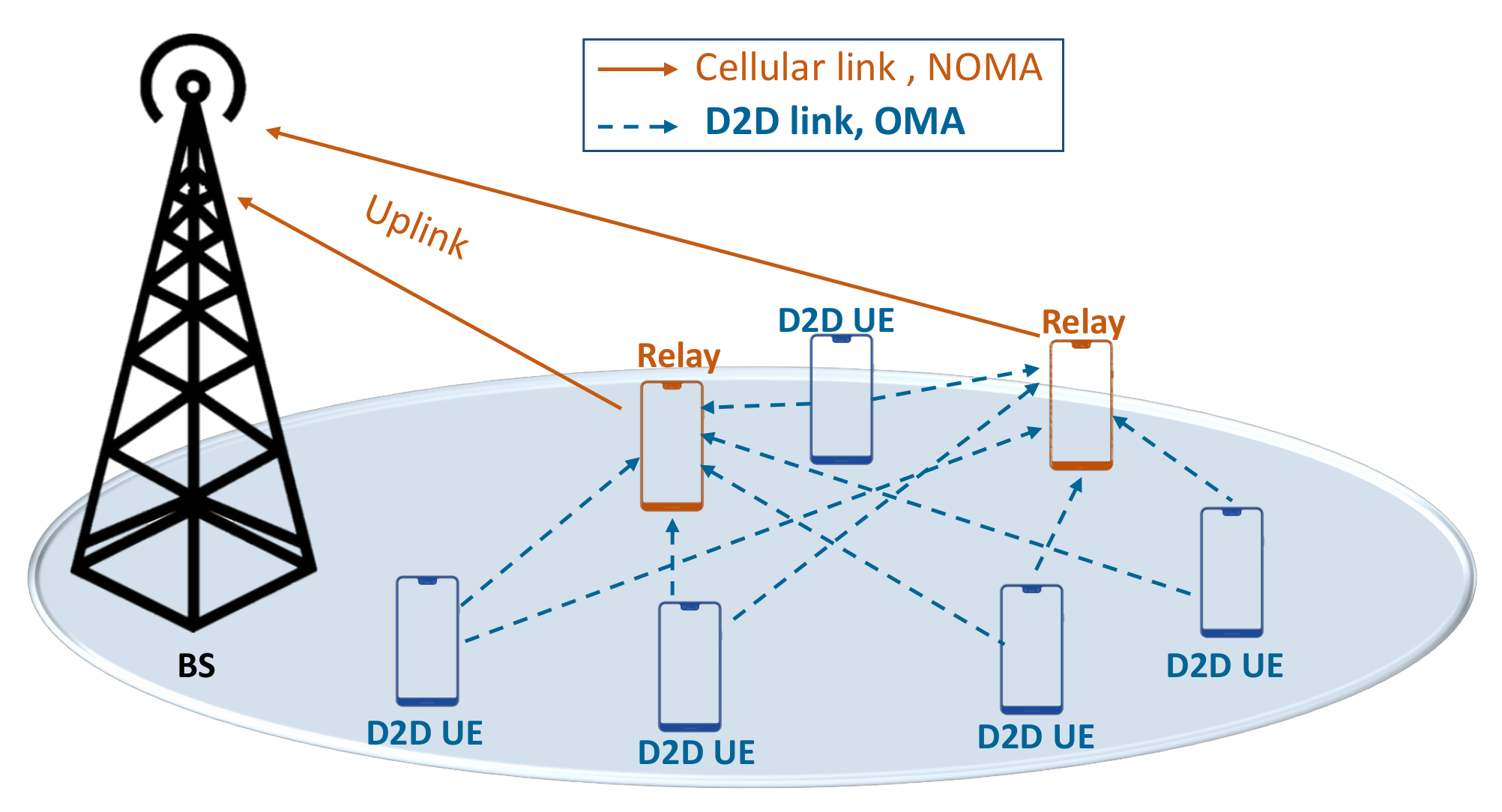
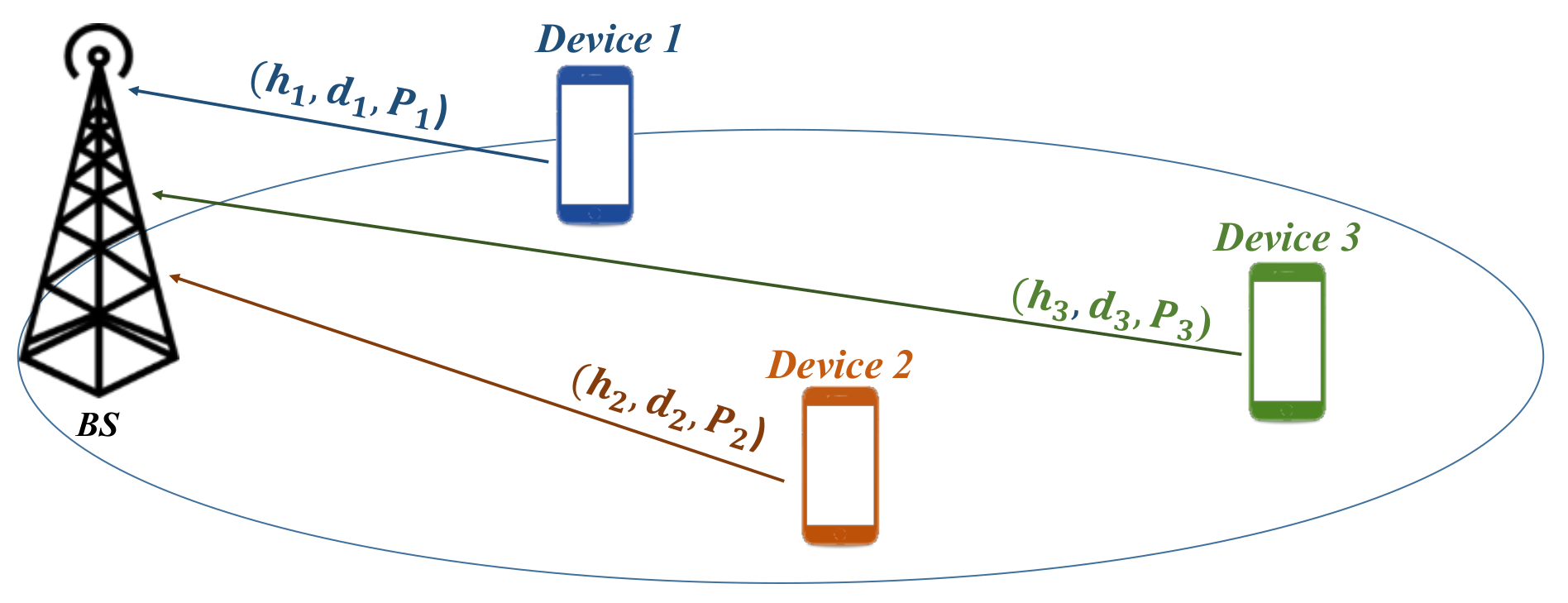
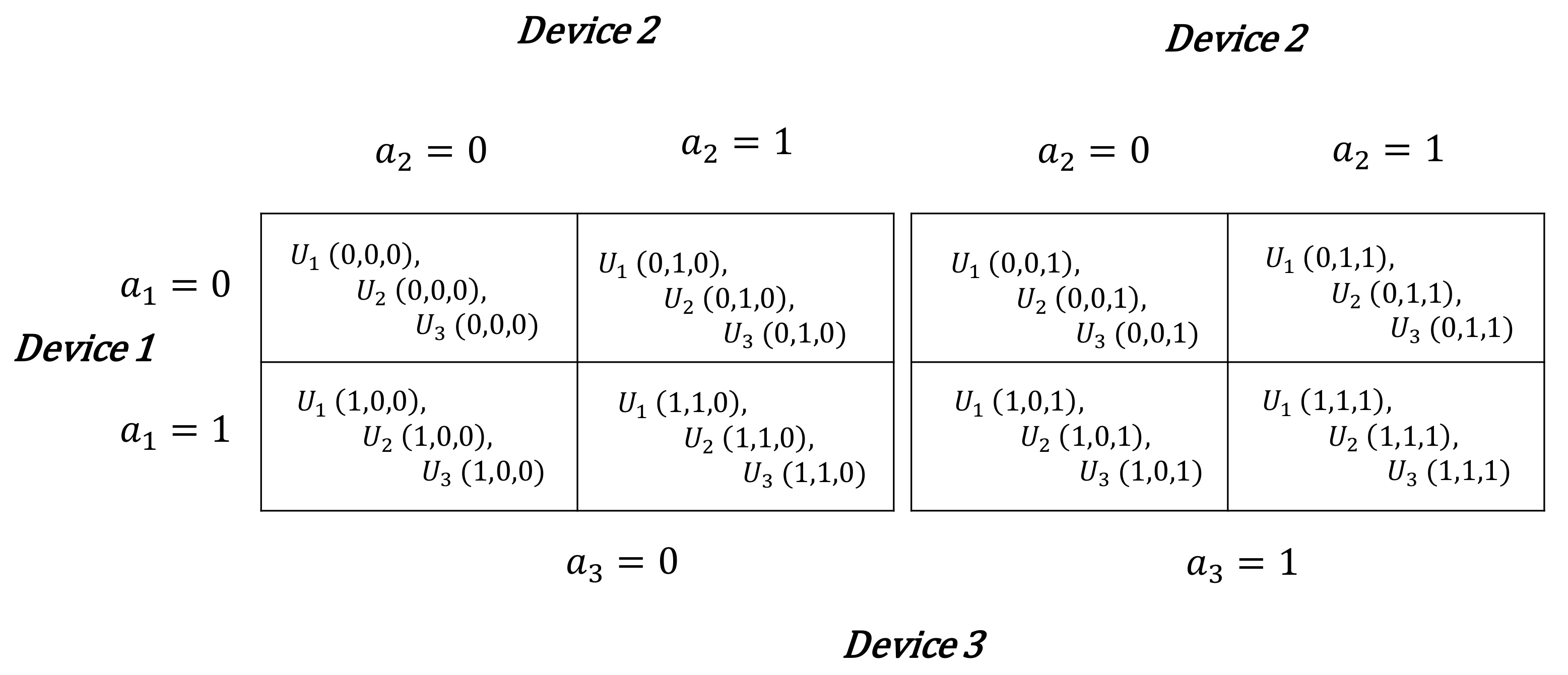
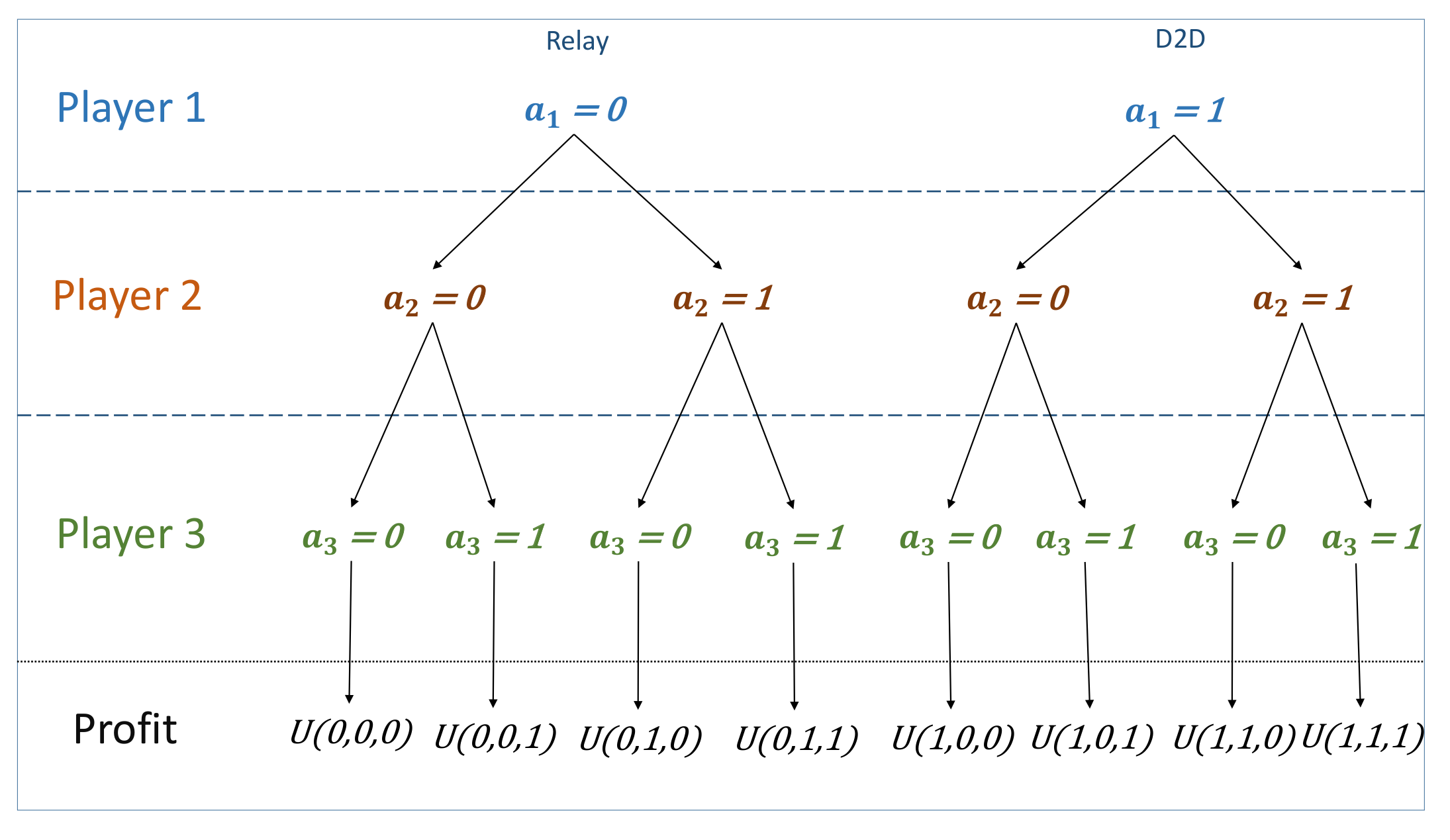
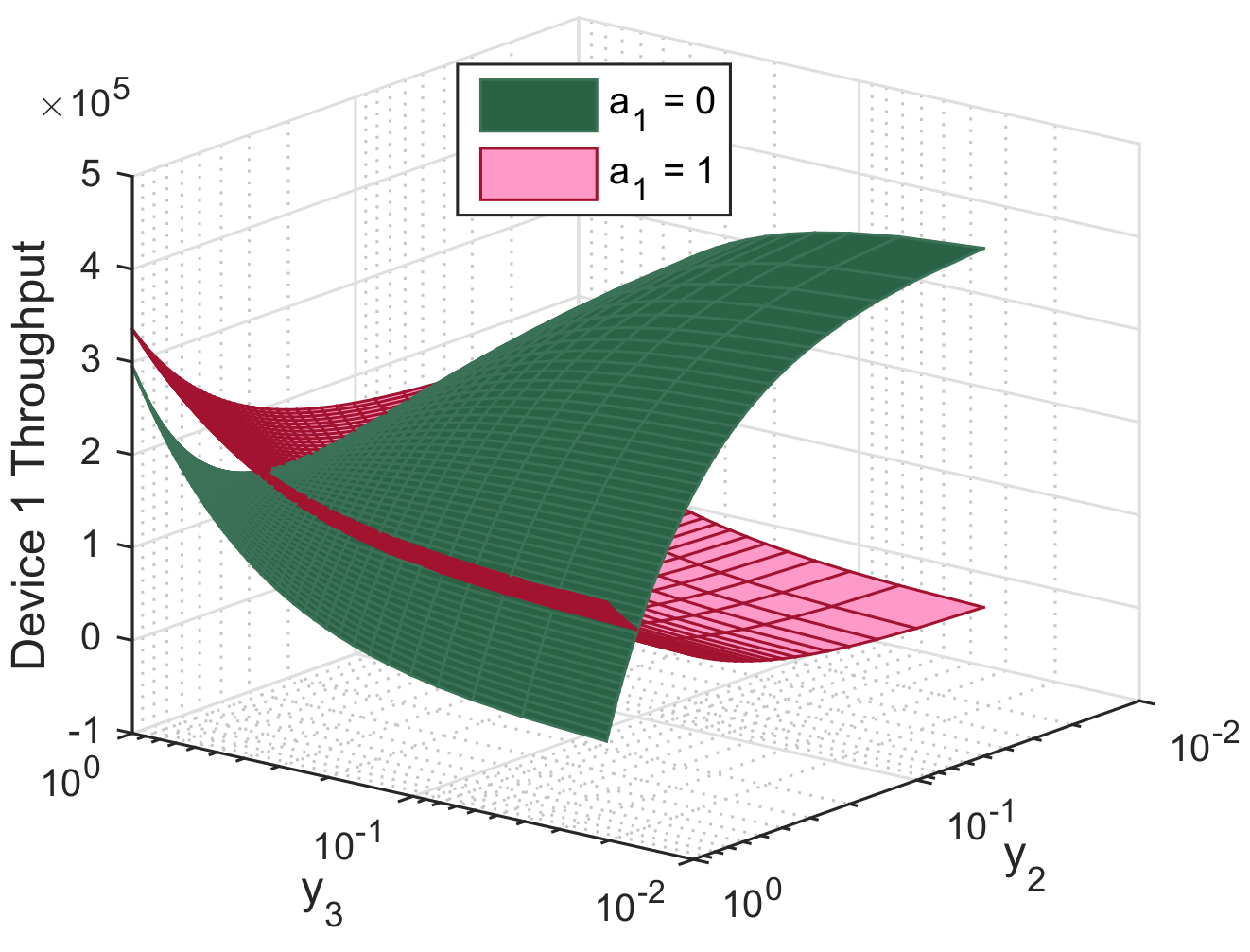
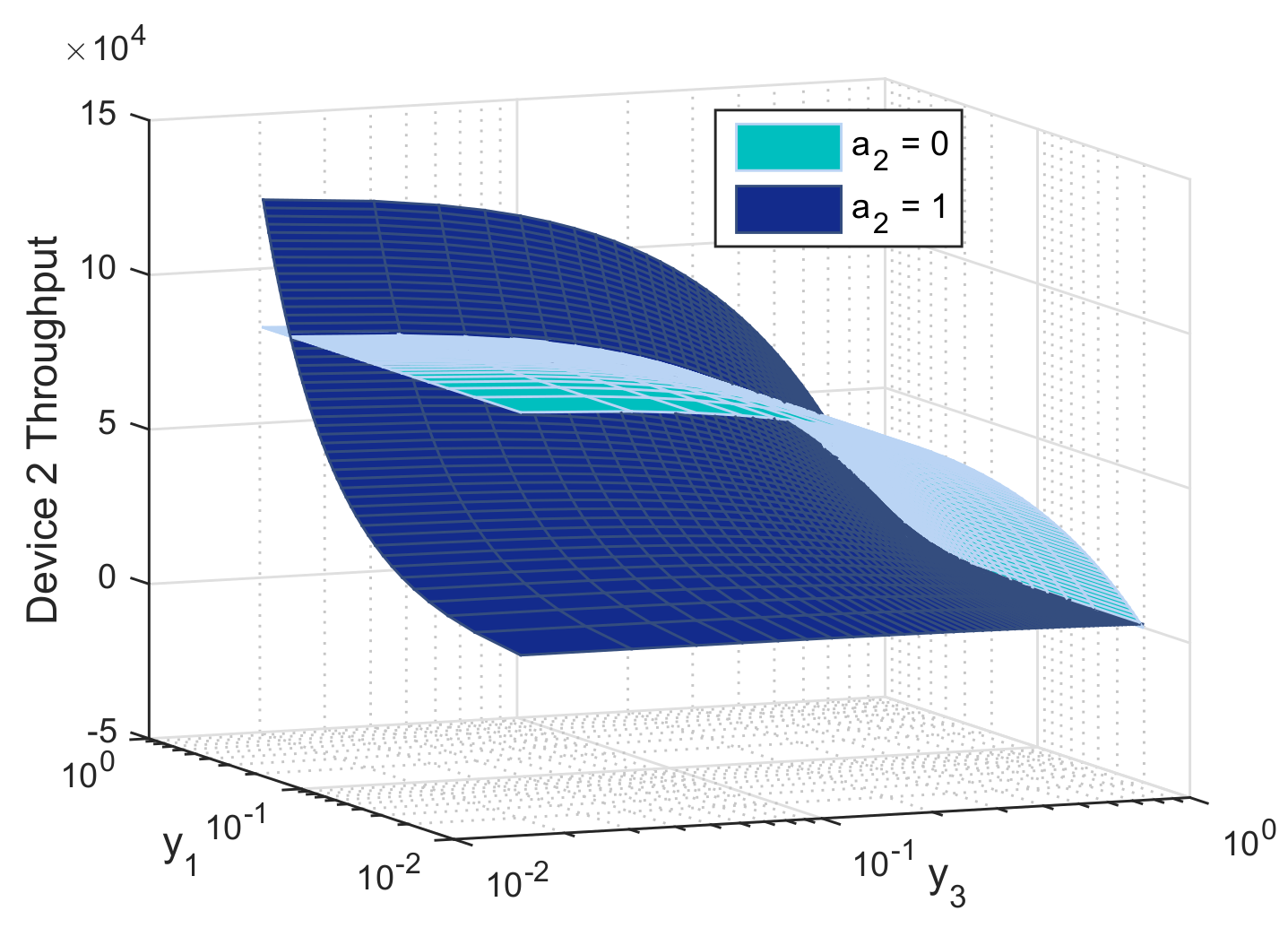
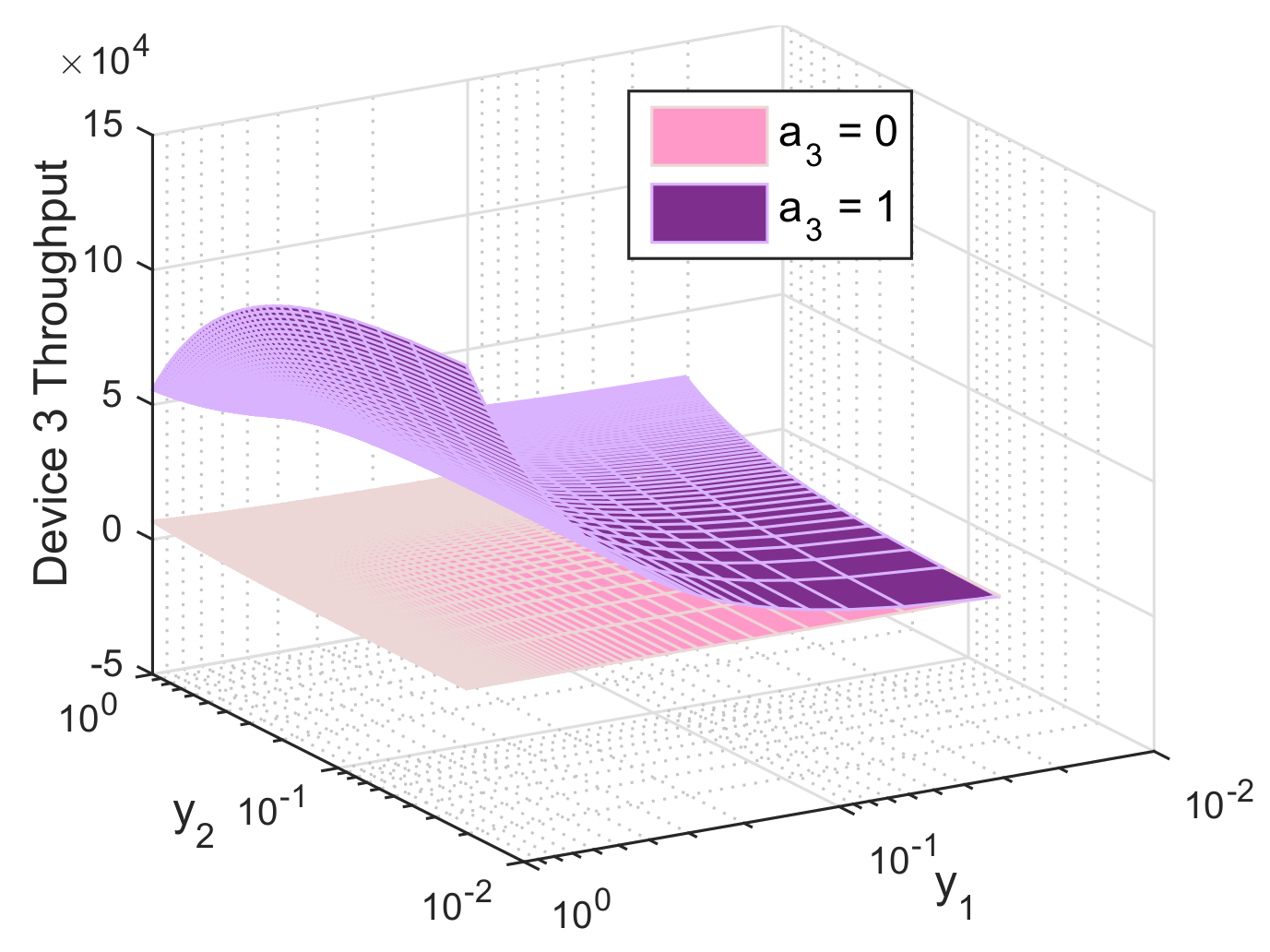
| Ref | D2D Mode | Multiple Access | Main Goal | Tools | UEs Access Mode |
|---|---|---|---|---|---|
| [32] | Underlay | OMA | Improve Cellular Coverage Quality | Optimization mechanism Greedy algorithm based on a distributed local search | - Cellular mode - Multi-hop D2D relaying mode |
| [33] | Overlay | OMA | Minimize the average energy consumption of flow transmission | Markov Decision Process | - Cellular mode - D2D mode |
| [34] | Underlay | OMA | Achieve high spectrum efficiency | Evolutionary game model | - Cellular mode - Direct reuse mode - D2D Relay mode |
| [35] | Underlay | OMA | Optimize the network energy efficiency- Maximize the number of connected D2D users | Fuzzy C mean - clustering algorithm | - Dedicated D2D mode - D2D reuse mode |
| [36] | Underlay | OMA | Increase the data rate Improve the energy efficiency- Satisfy stringent delay constraints | Energy Efficiency and Delay-Optimization algorithm based on the brute-force searching method | - Direct transmission - D2D-assisted relaying |
| [37] | Outband Underlay | Listen-before- talk (LBT)/ Duty-cycle method | Minimize the mutual interference - Guarantee the QoS requirements- Maximize the overall throughput | Heuristic algorithms | - Licensed reusing mode - Duty-cycle based - LBT based unlicensed modes |
| [38] | Underlay | OMA | Maximize the system throughput | Mode Selection and Resource Allocation algorithm based on Lagrangian dual decomposition | - Cellular mode - D2D mode |
| [39] | Underlay Overlay | OMA | Optimize the total throughput- Reduce interference | Probabilistic integrated resource allocation strategy Quasi-convex optimization algorithm | - Reusing Mode - Dedicated Mode - Cellular Mode |
| [40] | Underlay | OMA | Maximize the number of D2D users - Increase the system capacity - Improve the overall throughput | Greedy algorithm Heuristic algorithm | - Cellular mode - Direct D2D mode |
| Our work | Overlay | NOMA OMA | Pure and Mixed Equilibrium in terms of throughput and reliability | Game theory Distributed reinforcement learning | - Cellular mode - Relay mode - D2D mode |
| Symbol | Meaning |
|---|---|
| n | Number of devices in the cell |
| Transmission power of device i | |
| Distance between device i and the BS | |
| Channel gain of device i | |
| SINR of device i | |
| SINR-threshold | |
| Outage probability of device i | |
| Mean of the channel gain | |
| R | Transmission rate |
| Outage probability of device i if it communicates through cellular | |
| Outage probability of device i if it is a relay | |
| Outage probability of device i if it communicates through D2D | |
| Throughput of device i if it communicates through cellular | |
| Throughput of device i if it is a relay | |
| Throughput of device i if it communicates through D2D | |
| Transmission power of device i if it communicates through D2D | |
| Distance between device i and another D2D device | |
| f | Orthogonality factor |
| Path-loss exponent in cellular and D2D, respectively | |
| Fraction of throughput device i gives to D2D devices | |
| Utility of device i that denotes its throughput when choosing the action |
Publisher’s Note: MDPI stays neutral with regard to jurisdictional claims in published maps and institutional affiliations. |
© 2021 by the authors. Licensee MDPI, Basel, Switzerland. This article is an open access article distributed under the terms and conditions of the Creative Commons Attribution (CC BY) license (http://creativecommons.org/licenses/by/4.0/).
Share and Cite
Driouech, S.; Sabir, E.; Ghogho, M.; Amhoud, E.-M. D2D Mobile Relaying Meets NOMA—Part I: A Biform Game Analysis. Sensors 2021, 21, 702. https://doi.org/10.3390/s21030702
Driouech S, Sabir E, Ghogho M, Amhoud E-M. D2D Mobile Relaying Meets NOMA—Part I: A Biform Game Analysis. Sensors. 2021; 21(3):702. https://doi.org/10.3390/s21030702
Chicago/Turabian StyleDriouech, Safaa, Essaid Sabir, Mounir Ghogho, and El-Mehdi Amhoud. 2021. "D2D Mobile Relaying Meets NOMA—Part I: A Biform Game Analysis" Sensors 21, no. 3: 702. https://doi.org/10.3390/s21030702
APA StyleDriouech, S., Sabir, E., Ghogho, M., & Amhoud, E.-M. (2021). D2D Mobile Relaying Meets NOMA—Part I: A Biform Game Analysis. Sensors, 21(3), 702. https://doi.org/10.3390/s21030702






